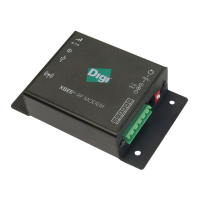Network commissioning and diagnostics Device discovery
XBee/XBee-PRO® S2C ZigBee® RF Module
110
Transparent operating mode configuration (AP = 0)
To send data to the loopback cluster ID on the data endpoint of a remote device:
1. Set the CI command to 0x12.
2. Set the SE and DE commands to 0xE8 (default value).
3. Set the DH and DL commands to the address of the remote (0 for the coordinator, or the 64-bit
address of the remote).
After exiting Command mode, the device transmits any serial characters it received to the remote
device, which returns those characters to the sending device.
API operating mode configuration (AP = 1 or AP = 2)
Send an Explicit Addressing Command frame - 0x11 using 0x12 as the cluster ID and 0xE8 as both the
source and destination endpoint.
The remote device echoes back the data packets it receives to the sending device.
RSSI indicators
It is possible to measure the received signal strength on a device using the DB command. DB returns
the RSSI value (measured in -dBm) of the last received packet. However, this number can be
misleading in ZigBee networks. The DB value only indicates the received signal strength of the last
hop. If a transmission spans multiple hops, the DB value provides no indication of the overall
transmission path, or the quality of the worst link; it only indicates the quality of the last link.
Determine the DB value in hardware using the RSSI/PWM device pin (TH pin 6/SMT pin 7). If you enable
the RSSI PWM functionality (P0 command), when the device receives data, it sets the RSSI PWM to a
value based on the RSSI of the received packet (this value only indicates the quality of the last hop).
You could connect this pin to an LED to indicate if the link is stable or not.
Device discovery
Network discovery
Use the network discovery command to discover all devices that have joined a network. Issuing the
ND command sends a broadcast network discovery command throughout the network. All devices
that receive the command send a response that includes:
n Device addressing information
n Node identifier string (see NI (Node Identifier))
n Other relevant information
You can use this command for generating a list of all module addresses in a network.
ZDO discovery
The ZigBee Device Profile includes provisions to discover devices in a network that are supported on
all ZigBee devices (including non-Digi products). These include the LQI Request (cluster ID 0x0031) and
the Network Update Request (cluster ID 0x0038). You can use the LQI Request to read the devices in
the neighbor table of a remote device, and the Network Update Request for a remote device to
complete an active scan to discover all nearby ZigBee devices. You can send both of these ZDO
commands using the XBee Explicit API transmit frame (0x11). For more information, see API
Operation. Refer to the ZigBee specification for formatting details of these two ZDO frames.

